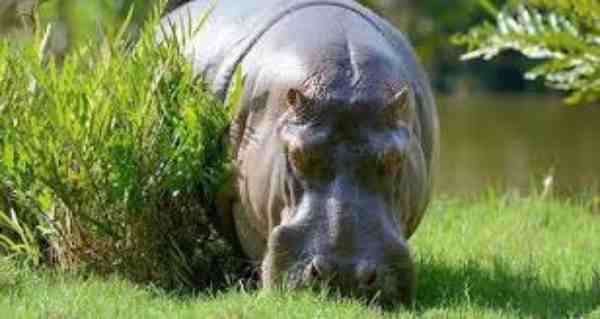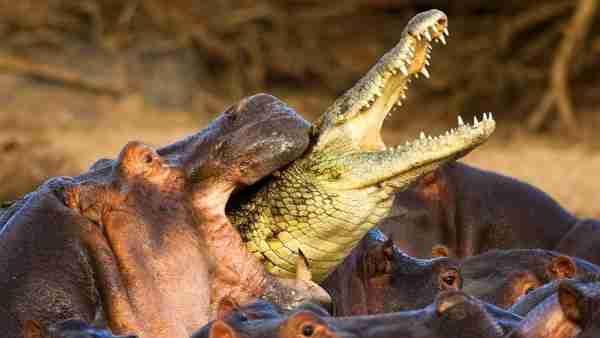Are hippos omnivores or herbivores? This issue has been under discussion for many years. Hippopotamuses have quite interesting eating habits. These residents of Africa inhabit rivers and streams that have soft grass nearby. They adore eating vegetables. Hippos, both common and pygmy, are totally reliant on vegetation. Hippopotamuses, however, occasionally engage in carnivorous behavior when food is scarce.
Table of Contents
There have been at least a dozen sightings coming out of southern Africa claiming to have seen carnivore hippopotamuses. There are also rumors that hippopotamuses have been seen dining on the remains of other members of their own species. Even though their stomachs were exclusively built to process plant matter, becoming sick from consuming an excessive amount of meat is possible.
Hippos are generally herbivorous animals, despite the fact that they sometimes engage in carnivorous behavior. Their diet is primarily composed of fruit, grasses, and aquatic plants.

Differentiation by Food Habits
Herbivores, carnivores, and omnivores are the three main categories that can be used to categorize different kinds of animals according to the food they eat. Herbivores are animals that get the majority of their nutrition from plants or other sources that derive from plants.
Because they convert the energy that is derived from green plants into a form that can be ingested by other creatures further up the food chain, these animals serve as the essential building blocks of the food chain. They come in all shapes and sizes, ranging from the size of the tiniest insects to that of the largest elephants, and everything in between.
Herbivores have stomachs that have been uniquely evolved to absorb plant stuff, and many herbivores have numerous chambers in their stomachs so that they can digest their meal even more quickly. They also have teeth that are flattened, making them excellent for the chopping of plant-based materials.
A great number of herbivores have diets that are tailored to the consumption of a particular component of trees, such as leaves, bark, fruits, berries, nectar, or aquatic plants. Some even consume dead vegetation.

Carnivores are animals that derive their nutrition from the consumption of flesh. Cats, hawks, snakes, bats, wolves, lions, and tigers are only a few of the animals that fall under this group. They are primarily adapted to hunt and consume herbivorous animals due to their biology.
In order to rip through tough cuts of meat, their teeth are pointed and sharp, and their digestive systems are adapted to absorb the protein found in animals. Because their digestive systems have been adapted to process meat, carnivores rarely experience any difficulties when digesting meat.
Animals are considered to be omnivores if they are able to consume and properly digest both plant and animal stuff. Humans, sharks, bears, dogs, raccoons, and pigs are all examples of omnivores in the animal kingdom. Bears will catch fish in rivers, but they also eat berries to satisfy their appetite.
They are able to chew on food that comes from a variety of sources because the molars and incisors in their jaws are both flat and sharp. Some herbivores and omnivores
Omnivores are able to digest a larger variety of foods than herbivores since their digestive processes are not specifically adapted for the breakdown of plant matter like herbivores’ are. On the other hand, this does not necessarily imply that the stomach is capable of easily digesting all forms of plant life.
To give just one illustration, people are unable to digest grass or any other type of plant that contains cellulose. Raccoons and other omnivores like them are capable of hunting their prey in the same manner as carnivores. Some animals, including bears, are known to consume the carcasses of deceased animals that they come across in the area.
Are Hippos Omnivores or Herbivores?
Hippos are amazing animals. But are hippos omnivores. Despite their size and fearsome appearance, they are essentially very kind creatures. Their stomachs are built to process the minerals present in plants, and the majority of them are vegetarians. However, when it comes to food, hippos can be possessive. In order to get a bigger part of the food, they frequently kill the weaker members of their society. They are probably acting in this way out of a desire to survive.
Hippopotami come out of the water after dusk to graze on grasses and other plants. They frequently plough taller vegetation aside to create “hippo lawns” because of their great affinity for short grasses. They grab the grass with their lips to begin eating, and then quickly move their heads to take it off.
Although hippopotamuses have long teeth, only the back teeth are really employed for chewing; the front teeth are primarily for display. Usually, they do not overly chew their food before swallowing it. Male hippopotami also communicate with one another by rapidly waving their tails while they urinate to define their territory.

Hippos can eat up to 1% to 1.5% of their body weight in plants each day. This equals an incredible 40 kg (88 pounds) of plants each night! Hippos spend about 5 to 6 hours grazing each evening because they are usually active at night. It’s interesting to note that pygmy hippos have a very different diet than their larger cousins.
These little hippos are native to the West African rainforests, and because of their adaptations, they can survive and even thrive there. The grasses, leaves, and ferns that grow next to rivers, streams, or swamps are what pygmy hippos enjoy eating. But are hippos omnivores. They spend a lot of time underwater and are typically most active after sunset. Pygmy hippos like to consume berries and roots that they discover in the jungle in addition to plants.
It’s not uncommon to witness common hippopotamuses nibbling on water plants. They eat lily pads in the water. They also enjoy hyacinths a lot. They may consume 200–300 pounds of hyacinth every day. They graze on grasses on the land for the majority of their food. Hippos are infamously violent animals, and they have been known to kill people who approach them too closely.
They may easily crush bones thanks to their strong jaws and keen teeth. 500 people are killed by hippos each year in Africa. They might not seek out humans to consume, but their size and strength make them extremely dangerous creatures.
However, their food is more constrained in captivity. The majority of the time, zoos will provide them with a variety of diets, ranging from hay to pellets. Generally speaking, hippos are able to adjust to their new environment and continue to thrive in captivity.
Some of the most voracious eaters are hippopotami. Hippos are not picky eaters, unlike many other herbivores, and will eat practically any plant-based food. Straw, lettuce, veggies, and pumpkins may be included in their diet when kept in captivity.
For dinner, they might also receive items like bamboo, grain, hay, cucumber, and yellow squash. Some zoos even give them beet pulp that has been dried. Hippos normally eat the majority of their meals at night, though sometimes they are given watermelons or other fruits.
They begin emerging from the water alone or with their calf around dusk. A mother hippo may survive without feeding or leaving the water for several days. She waits until her calf is strong enough to begin grazing since the larger males might attack a weaker calf. Mother hippos must therefore be extremely cautious when deciding when and where to graze.
They are submerged in water for the majority of the day, which helps to keep their bodies cool and wet. Hippos spend roughly 16 hours each day submerged, returning to the water in the evening to eat. They like to remain idle for the majority of the day, yet they do occasionally travel to land.
Hippos can store enough vegetation for many days in their stomachs to last them up to three weeks without food, so this habit helps to maintain their moisture levels and aids in digestion. Hippos may go for extended periods of time without eating because of their slow metabolic rate. To survive the frequent dry seasons in Africa, this adaptability is necessary.

What Do Hippos Eat? How Frequently do Hippos Consume Non-vegetarian Food?
Hippopotamuses have occasionally been observed eating meat in acts. When other food sources are scarce due to drought or famine, this is most likely to happen. Even while flesh may account for a sizable portion of their diet at this stage, it is not their favored food. Hippos will always opt for vegetation over meat if given the choice.
They have been known to hunt and consume larger animals like kudus, impalas, and even buffalo when conditions are dry and food is scarce. They have even been known to attack zebras, elephants, and wildebeests on occasion. Although hippos are not typically predators, if they are very hungry, they will steal the kills of other animals.
They have a history of attacking other species in captivity, including tapirs, flamingos, and pygmy hippos. Although the exact cause of these attacks is unknown, it is believed that hippos may grow irritated or upset in small places and lash out as a result.
Hippos have been known to assault and kill crocodiles in the wild. Though they may seem like unlikely bedfellows, hippopotamuses and crocodiles often coexist in the wild. Though hippopotamuses don’t typically eat crocodiles, they can be aggressive if they feel threatened.
Hippos are occasionally reported to eat insects, Fish is not something that the semiaquatic creatures enjoy eating on their diet. However, there are only a few isolated accounts of common hippos feeding on fish. These kinds of behaviors are categorized as abnormal and attributed to high levels of stress by the scientific community.
Hippos Cannibalise?
Surprisingly, there are a lot of animals that eat other animals, and there are many reasons why animals might do this. Hippos usually eat plants, but there are two confirmed reports of hippos eating each other.
Leejiah Dorward, a Ph.D. student at Imperial College London, told about the most recent incident. Mr. Dorward was on a safari in South Africa’s Kruger park when he saw a hippopotamus eating its own kind. He took a picture of the event.
Before that, there had been only one confirmed report of a hippo eating another hippo, from 1999. Mr. Dorward found out that cannibalism is rare among hippos and that both times it happened, there was a lack of food.
This suggests that when food is scarce, animals might be more likely to eat each other. Even though it is not clear why some animals eat other animals and others don’t, it is clear that this is a more common occurrence than many people think.

Hippopotami Physical Adaptation
The body of a hippopotamus is unlike any other in the animal kingdom. These enormous animals have been spotted in the waterways of sub-Saharan Africa, including rivers and canals. It comes as a bit of a shock to quite a few researchers to learn that grass-eating mammals can reach such massive proportions. Their digestive systems have become specialized for the consumption of grass after thousands of years of evolution.
Lips: Their lips are enormous, and the interior of their mouth is very roomy. They shred the grass with their lips and chew with the teeth in the back of their mouths.
Teeth: Out of all the terrestrial animals, they have the largest teeth possible. Their incisors have the potential to reach a length of up to 1.2 feet, while their canines have the potential to outgrow other canines and reach a length of up to 1.5 feet.
Because the jaw hinges are located so far in the back, the giants can open their mouths to an angle of roughly 180 degrees. The front teeth are typically utilized during interactions with members of other species, whereas the back molars are used to crush food.
Stomach: Hippopotamus has a stomach that is divided into three distinct chambers. It’s kind of like a fermentation plant with three separate chambers. The stomach is structured in such a way that it extracts the most level of nourishment possible from the plant matter that they consume. Hippos have intestines that are significantly longer than those of other herbivores. Because of this, they are able to carry out the process of heavy digesting for a greater length of time across all plants.
Baby Hippos Getting Fed
The sight of young hippos is very breathtaking. They can be delivered on land or in the water, depending on where the mother feels most comfortable giving birth. Calves are normally delivered one at a time after a gestation period that lasts close to eight months. The mother will provide care for her calf for up to two weeks, or until the calf is healthy enough to join the rest of the herd.
When calves are first brought to zoos, they are given their mother’s milk to consume until they are old enough to begin eating more sophisticated foods. For instance, the young hippopotamus named Fiona who lives at the Cincinnati Zoo initially consumes her mother’s milk as well as formula before going on to a diet that consists of daily meals of pre-chewed hay and mushy grain.

The Hippopotamus’s Role in the Animal Food Chain
Though they may look sluggish, hippopotami are actually key players in the food chain. As herbivores, they consume large quantities of grass, which helps to keep the vegetation from becoming overgrown. In turn, this benefits the animals that rely on the grass for food.
When hippos are hunted by predators, their meat is rich in nutrients that help to sustain the carnivores. In this way, hippos play an important role in maintaining the balance of nature.

Final Words
I appreciate you staying with us! We sincerely hope that you enjoyed reading our post and learned something new about hippos and their eating habits. We find their diet to be quite intriguing, particularly the fact that they can get by on such a huge intake of food. Was there anything that shocked you, caught your attention, or made you feel particularly icky? Comment below and let us know! Once more, thanks for reading.
Read our other Hippo blogs below:
- Can Hippos Jump?AnimalsResearch.com
- What Color is a Hippo? Learn True Facts
- Do Hippos Live in Ocean? Is It True Or False
- What Is A Hippos Bite Force?
- Hippo Mouth: Size and Facts
- Hippo Pregnancy | How Long Does a Hippo Pregnancy Last?

Jeevan Kodiyan
An animal enthusiast with an interest in zoology, studying the behavior and activities of animals in the wild habitat. I work on research projects related to species conservation and endangered species protection. I also leverage zoology to become an educator, educating others about the importance of protecting our natural environment and the beauty of animals in their natural habitats.









